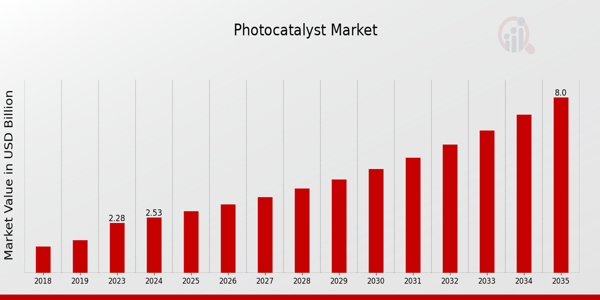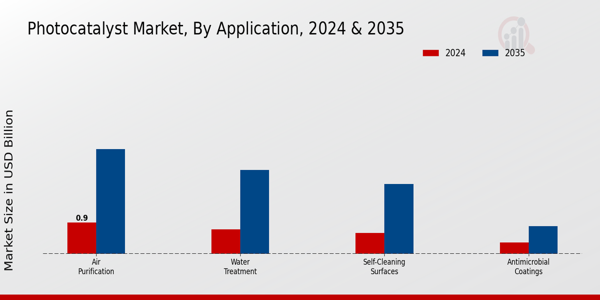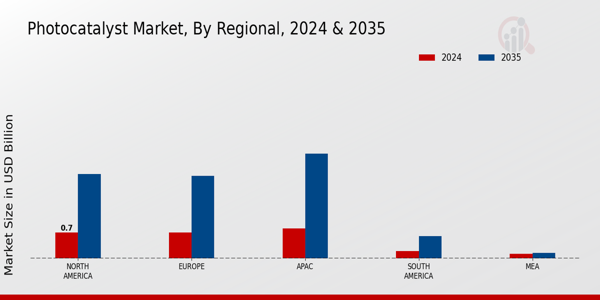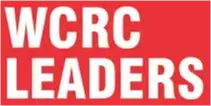Global Photocatalyst Market Overview
As per MRFR analysis, the Photocatalyst Market Size was estimated at 2.28 (USD Billion) in 2023. The Photocatalyst Market Industry is expected to grow from 2.53 (USD Billion) in 2024 to 8.0 (USD Billion) by 2035. The Photocatalyst Market CAGR (growth rate) is expected to be around 11.03% during the forecast period (2025 - 2035).
Key Photocatalyst Market Trends Highlighted
The Photocatalyst Market is witnessing significant growth driven by increasing awareness of environmental issues and a strong emphasis on sustainable technologies. One of the key market drivers is the rising demand for air and water purification solutions. Photocatalysts, particularly titanium dioxide, are known for their ability to break down pollutants under light activation, making them highly sought after in various applications. Additionally, they are gaining traction in construction and coatings, where they are used to produce self-cleaning surfaces. The push for stricter environmental regulations worldwide also propels the market forward as industries seek efficient ways to comply with environmental standards.There is a large scope for growth in the photocatalyst market; there exists a potential for research and development of advanced photocatalytic materials and processes. Thus, the performance and applications can be extended. An application of photocatalysis in building materials or in vehicle emission control systems can overcome specific environmental issues. There is increasing focus on alternative energy sources that could lead to more work on sophisticated photocatalytic reactors aimed at hydrogen generation. Also, further investment in R&D could pave the way for further innovations, which would make photocatalysts more cost-effective and better performing. Lately, there has been a trend towards the development of hybrid photocatalytic systems, integrating photocatalysis with biocatalysis and nanotechnology.
These hybrid systems promise to improve efficiency and expand applications in various sectors like healthcare and agriculture. Furthermore, consumer awareness about sustainability is prompting manufacturers to adopt photocatalytic solutions. The market is also impacted by technological advancements that enhance photocatalytic efficiency and reduce costs, encouraging adoption across various industries. Overall, the future looks promising as the photocatalyst market continues to evolve and adapt to new challenges and opportunities.

Photocatalyst Market Drivers
Increasing Demand for Environmental Applications
The growing concern for environmental pollution and the urgency to find effective remediation solutions are driving substantial opportunities within the Photocatalyst Market Industry. As governments and industries strive to achieve sustainability goals, photocatalysts are gaining traction for their ability to degrade pollutants and harmful substances in water and air. The market can witness a notable increase in demand for photocatalytic materials that are employed in various applications such as air purification, wastewater treatment, and the breakdown of organic contaminants.This trend is bolstered by legislative measures aimed at reducing carbon footprints and achieving cleaner environments. Companies within the Photocatalyst Market Industry are focusing on research and development to enhance the efficiency of photocatalysts, making them more applicable in diverse environmental scenarios. Furthermore, the push towards innovative solutions for environmental challenges ensures that the market remains focused on developing photocatalysts that are effective, cost-efficient, and capable of operating under various environmental conditions.This strategic shift not only underscores the importance of photocatalysts in combating pollution but also highlights their pivotal role in the transition towards a sustainable future, thereby creating a robust market environment for growth and expansion.
Technological Advancements in Photocatalysts
Technological innovations are significantly enhancing the performance and application range of photocatalysts within the Photocatalyst Market Industry. Continuous advancements in materials science enable the development of more efficient photocatalytic materials that can operate under broader spectrum light conditions. These innovations include the improvement of existing photocatalysts and the emergence of novel compounds, which are crucial for applications in energy conversion, self-cleaning materials, and sustainable chemical processes.The increasing capability of these photocatalysts makes them suitable for integration into various industries, including construction, pharmaceuticals, and food and beverage. The Photocatalyst Market is thus poised for growth as these technological developments streamline production processes and expand the adaptability of photocatalysts across different environmental and industrial applications.
Growing Construction Activities and Urbanization
The rising urbanization and accelerating construction activities globally are contributing significantly to the expansion of the Photocatalyst Market Industry. With the increasing number of urban populations, there is a heightened focus on constructing buildings and infrastructure that not only meet aesthetic demands but also environmental sustainability criteria. Photocatalytic materials are being increasingly utilized in construction for their ability to purify air and reduce the overall environmental impact of buildings.This trend is further enhanced by the growing interest in smart cities and green building certifications, which promote the use of sustainable materials. Consequently, the construction industry's evolving requirements serve as a substantial driver for the proliferation of photocatalytic applications, therefore strengthening the overall market growth.
Photocatalyst Market Segment Insights
Photocatalyst Market Application Insights
The Photocatalyst Market revenue is showcasing a steady growth trajectory, with an expected valuation of 2.53 USD Billion in 2024 and a significant rise to 8.0 USD Billion by 2035, underscoring the demand and technology advancements within the application segment. This segment encompasses key areas such as Air Purification, Water Treatment, Self-Cleaning Surfaces, and Antimicrobial Coatings, each contributing distinctly to the overall market dynamics. Among these, Air Purification is leading with a valuation of 0.9 USD Billion in 2024, set to expand to 3.0 USD Billion by 2035.This growth is pivotal due to increasing environmental concerns and the necessity for clean indoor air, making it a major player in the market. Water Treatment follows closely, valued at 0.7 USD Billion in 2024 and projected to grow to 2.4 USD Billion by 2035, driven by the global focus on sustainable practices and access to clean water. Moreover, Self-Cleaning Surfaces, valued at 0.6 USD Billion in 2024 with a future forecast of 2.0 USD Billion in 2035, indicates an escalating interest in innovative materials that enhance convenience and hygiene, marking a significant trend in consumer preferences.Conversely, Antimicrobial Coatings, while more niche, starts with a valuation of 0.33 USD Billion in 2024 and aims for 0.8 USD Billion by 2035, reflecting a growing appreciation for surfaces that can inhibit microbial growth, particularly in healthcare and public spaces. The substantial growth in these applications highlights various market growth drivers, including a rising awareness of health and safety standards, technological advancements in photocatalytic materials, and the increasing regulations on air and water quality worldwide. However, challenges such as high manufacturing costs and the need for further research and development to enhance the efficiency of photocatalytic processes remain.Meanwhile, opportunities lie in emerging markets and the integration of photocatalyst technology across diverse industries, promising prospects for expansion in the Photocatalyst Market industry. This segmentation of the market further illustrates the Photocatalyst Market statistics, showcasing not only where the market stands today but also its potential for future growth across various application domains.

Photocatalyst Market Type Insights
The Photocatalyst Market segmentation by Type has shown a dynamic landscape, highlighting the increasing importance of various materials in this industry. With a projected market valuation of 2.53 billion USD by 2024, the demand for photocatalysts is notably driven by their application in environmental remediation, self-cleaning surfaces, and energy conversion technologies. Titanium Dioxide emerges as a predominant player due to its superior photocatalytic efficiency, making it highly sought after for air purification and water treatment.Zinc Oxide follows closely, recognized for its effectiveness in UV protection and antimicrobial properties, thereby catering to sectors such as cosmetics and construction. Composite Photocatalysts are gaining traction as they combine the advantages of various materials, enhancing stability and performance under diverse conditions. The Photocatalyst Market revenue reflects the continuous growth in these segments, influenced by advancements in technology and growing environmental concerns. Market trends show a strong shift towards sustainable solutions, and this presents significant opportunities for innovation and expansion within the Photocatalyst Market industry.Factors such as regulatory support and heightened awareness of air and water quality further bolster the growth outlook for this market segment.
Photocatalyst Market End Use Industry Insights
The Photocatalyst Market is projected to experience significant growth, with a valuation expected to reach 2.53 billion USD by 2024. This market is notably influenced by various end-use industries, which all play a critical role in driving demand. The construction sector is essential, as photocatalysts are increasingly being used for self-cleaning materials and air purification. Similarly, the textile industry benefits from photocatalysts for their anti-bacterial properties and stain resistance. In the automotive sector, these materials are valuable for surface coatings that enhance durability and reduce emissions, reflecting a trend towards more eco-friendly solutions.Healthcare is another crucial area where photocatalysts contribute to sterilization processes, thereby improving sanitation and safety. The electronics sector also sees a significant impact from photocatalysts utilized in the production of displays and photovoltaic devices. The diverse applications across these industries demonstrate the widespread significance and utility of photocatalysts in modern technology and infrastructure. Market growth is further supported by the increasing emphasis on sustainability and environmental responsibility in various industrial practices.As the Photocatalyst Market continues to evolve, these end-use industries are expected to be at the forefront of this transformative journey.
Photocatalyst Market Formulation Insights
The Photocatalyst Market within the Formulation segment is set to witness significant growth, as it is projected to reach a valuation of 2.53 USD Billion by 2024, with expectations of maintaining robust momentum towards a valuation of 8.0 USD Billion by 2035. This segment encompasses various formulations, including Powder, Liquid, and Spray, each playing a vital role in addressing diverse industry needs. Among these, Powder formulations are often regarded for their superior efficacy in environmental applications, such as air purification and water treatment, while Liquid formulations showcase versatility in consumer products and industrial uses.Spray formulations are increasingly being adopted for convenience in application, especially in home care solutions. The increasing demand for sustainable solutions, regulatory changes promoting environmental safety, and technological advancements are factors driving market growth. However, challenges such as the need for consistent quality and performance across different formulations persist. Overall, the Photocatalyst Market data highlights a sector poised for expansion, with diverse formulation options catering to an array of applications, underpinning the importance of this segment within the broader market landscape.
Photocatalyst Market Regional Insights
The Photocatalyst Market is projected to reach a valuation of 2.53 USD Billion by 2024, with significant growth expected across various regions. North America and Europe each hold a valuation of 0.7 USD Billion in 2024, showcasing their poised roles in the market, while the APAC region leads with a value of 0.8 USD Billion, indicating its rapid industrial growth and adoption of photocatalytic technologies. By 2035, the North America segment is expected to increase to 2.25 USD Billion, further establishing it as a major contributor to the Photocatalyst Market revenue.Europe is expected to show a similar trend, reaching 2.2 USD Billion as environmental regulations propel its market forward. The APAC region continues to dominate with a projected increase to 2.8 USD Billion, reflecting its significant potential fueled by urbanization and industrial activities. In contrast, South America and the MEA regions hold smaller market shares, valued at 0.2 USD Billion and 0.13 USD Billion in 2024, respectively, but are gradually growing, suggesting opportunities for expansion and investment in photocatalytic solutions.The overall market dynamics reflect an increasing emphasis on sustainable technologies and innovations across all regions.

Photocatalyst Market Key Players and Competitive Insights
The Photocatalyst Market has undergone significant transitions, driven by an increasing awareness of sustainable practices and environmental pollution control technologies. Photocatalysts, materials that facilitate chemical reactions upon exposure to light, have garnered attention for their applications in air purification, water treatment, and self-cleaning surfaces. With diverse players in the market, the competitive landscape is dynamic, with companies investing heavily in research and development to enhance product efficacy and performance. The advancements in photocatalytic technologies are reshaping market strategies as firms continuously seek to differentiate their offerings amidst growing environmental concerns and regulatory pressures. Stakeholders are increasingly focused on innovation and sustainability, which presents both challenges and opportunities for market participants.Kahataguru has established a notable presence in the Photocatalyst Market, recognized for its innovative approach and commitment to environmental sustainability. Its strength lies in the development of advanced photocatalyst materials that exhibit high efficiency and durability. The company utilizes proprietary technologies and skilled expertise to create products that not only meet industry standards but also cater to the growing demand for eco-friendly solutions. Kahataguru's ability to form strategic partnerships further enhances its market position, enabling collaborative projects that expand its reach in various application sectors. With a robust pipeline of research initiatives, Kahataguru continues to drive growth and improvement in photocatalytic processes, enhancing its reputation as a leader in the field.SABIC, a key player in the Photocatalyst Market, leverages its extensive resources and knowledge in material science to develop high-quality photocatalytic solutions. The company boasts a strong portfolio of products tailored to meet the evolving needs of industrial sectors seeking sustainable practices. SABIC's strengths are highlighted by its focus on innovation, as it continually invests in research and development efforts aimed at enhancing the photocatalytic performance and application versatility of its materials. The company’s global footprint allows it to cater to a wide range of markets, providing customized solutions that align with local regulatory requirements and sustainability initiatives. Additionally, SABIC's commitment to sustainable manufacturing processes reinforces its competitive edge, positioning the company favorably in a market that increasingly prioritizes environmental responsibility.
Key Companies in the Photocatalyst Market Include
- Kahataguru
- SABIC
- Cymetech
- Sika
- BASF
- Kuraray
- Taobao
- Dow Chemical
- Toshiba
- Nippon Steel
- Titan Kogyo
- Mitsubishi Chemical
- Kyoto University
- Huntsman
Photocatalyst Market Industry Developments
The Photocatalyst Market has been witnessing several significant developments recently. Companies such as BASF and Mitsubishi Chemical are intensifying their research efforts on photocatalytic applications to reduce environmental impact, driven by the growing demand for sustainable technologies. This trend is accompanied by increasing investments in the market, as emerging entities like Cymetech and Kahataguru are introducing innovative photocatalyst solutions aimed at various applications, including air purification and water treatment. Current affairs indicate a focus on infrastructure improvements, with Sika collaborating with construction projects that utilize photocatalytic materials for self-cleaning surfaces. Regarding mergers and acquisitions, recent merger activity reflects a strategic consolidation in the market, particularly with Dow Chemical and SABIC exploring partnerships that enhance their photocatalytic product offerings. Companies such as Kuraray and Titan Kogyo are also boosting their market presence through collaborations aimed at enhancing product distribution. The valuation of companies within the Photocatalyst Market is on the rise, indicating robust growth potential influenced by regulatory pressures favoring cleaner products and technology advancements. Overall, the landscape of the Photocatalyst Market is evolving significantly, characterized by innovation, partnerships, and a heightened emphasis on environmental sustainability.
-
Photocatalyst Market Segmentation Insights
-
Photocatalyst Market Application Outlook
- Air Purification
- Water Treatment
- Self-Cleaning Surfaces
- Antimicrobial Coatings
-
Photocatalyst Market Type Outlook
- Titanium Dioxide
- Zinc Oxide
- Composite Photocatalysts
-
Photocatalyst Market End Use Industry Outlook
- Construction
- Textiles
- Automotive
- Healthcare
- Electronics
-
Photocatalyst Market Formulation Outlook
-
Photocatalyst Market Regional Outlook
-
North America
-
Europe
-
South America
-
Asia Pacific
-
Middle East and Africa
| Report Attribute/Metric |
Details |
| Market Size 2023 |
2.28 (USD Billion) |
| Market Size 2024 |
2.53 (USD Billion) |
| Market Size 2035 |
8.0 (USD Billion) |
| Compound Annual Growth Rate (CAGR) |
11.03% (2025 - 2035) |
| Report Coverage |
Revenue Forecast, Competitive Landscape, Growth Factors, and Trends |
| Base Year |
2024 |
| Market Forecast Period |
2025 - 2035 |
| Historical Data |
2019 - 2024 |
| Market Forecast Units |
USD Billion |
| Key Companies Profiled |
Kahataguru, SABIC, Cymetech, Sika, BASF, Kuraray, Taobao, Dow Chemical, Toshiba, Nippon Steel, Titan Kogyo, Mitsubishi Chemical, Kyoto University, Huntsman |
| Segments Covered |
Application, Type, End Use Industry, Formulation, Regional |
| Key Market Opportunities |
Increasing demand for air purification, Growth in renewable energy applications, Expanding applications in wastewater treatment, Rising adoption in construction materials, Advancements in photocatalyst materials technology |
| Key Market Dynamics |
Increasing environmental regulations, Growing demand for clean energy, Advancements in nanotechnology, Rising applications in air purification, Expanding construction and automotive industries |
| Countries Covered |
North America, Europe, APAC, South America, MEA |
Frequently Asked Questions (FAQ) :
The Photocatalyst Market is expected to be valued at 2.53 USD Billion in 2024.
By 2035, the overall market is expected to reach a value of 8.0 USD Billion.
The market is expected to grow at a CAGR of 11.03% during the period from 2025 to 2035.
In 2024, Air Purification will be the highest valued application segment at 0.9 USD Billion.
The Water Treatment application segment is expected to be valued at 2.4 USD Billion in 2035.
The APAC region is expected to grow significantly, with a market value of 2.8 USD Billion in 2035.
Major players in the market include BASF, Dow Chemical, and Mitsubishi Chemical, among others.
The Antimicrobial Coatings segment is projected to be valued at 0.8 USD Billion in 2035.
The North America region is expected to have a market value of 0.7 USD Billion in 2024.
The European market is anticipated to reach a value of 2.2 USD Billion by 2035.





























